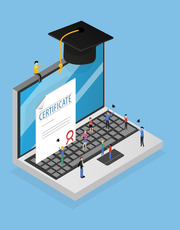Learning From Anywhere: Is Online High School Safe for Your Teen?
Is the theory that online high school is a safe educational platform for your teenager entirely accurate? You’ve likely heard the benefits: flexible schedules, personalized learning, and a vast array of course options.
Yet, as you’re well aware, the Internet is a double-edged sword, with its own set of potential pitfalls and hazards. These potential risks might make you reconsider. Is it possible for your teen to reap the rewards without falling prey to the dangers?
Let’s explore this together.
Understanding Online High School
To fully appreciate the safety measures in online high schools, it’s crucial to first understand what an online high school entails. Online high schools, also known as virtual schools, are institutions that offer secondary education through the internet. This education model can be either fully online, where all courses are completed remotely, or blended, where a portion of the curriculum is online, and the remainder is in a traditional classroom setting.
You might wonder why anyone would choose an online high school over a traditional one. Well, online high schools offer flexibility that brick-and-mortar schools can’t. They allow students to learn at their own pace and on their schedule, which can be a boon for those with other commitments, such as sports or part-time jobs.
Furthermore, online high schools often provide a wide array of courses that may not be available in traditional schools. For instance, online schools may offer specialized courses in coding or digital marketing, equipping students with practical skills for the digital age.
However, as with any online platform, online high schools come with potential safety risks. The next section will explore these risks and discuss how they can be mitigated.
The Evolution of Digital Education
Before we address the safety concerns inherent to online high schools, it’s helpful to understand how digital education has evolved over time. You might remember the start of this revolution with educational software on PCs. These rudimentary programs laid the foundation for today’s sophisticated digital learning environment.
As internet access expanded, so too did the opportunities for remote learning. The late 90s and early 2000s saw a boom in online colleges, paving the way for high school students to access courses virtually. In the last decade, advances in technology have further propelled this evolution. Mobile devices, interactive platforms, and high-speed internet have made it possible for students to engage with their coursework from anywhere, at any time.
However, as the technology improved, so did the need for regulations and standards to guarantee quality and safety. Accreditation bodies emerged to vet these digital institutions, providing a seal of approval for those meeting rigorous academic and ethical criteria.
This evolution hasn’t been without its challenges, but the continuous improvement in technology and oversight has made online high school a viable option for many families. Yet, as with any form of education, it’s important to weigh the benefits against the potential risks.

Benefits of Online High School
Opting for an online high school can offer a myriad of benefits, including flexibility, individualized learning, and expanded course offerings. Flexibility allows your teen to learn at their own pace, on their own time. This can be especially beneficial if your teen has other commitments, such as sports, a part-time job, or family obligations.
The individualized learning offered by online high schools allows your teen to focus on areas where they may need extra help, while also enabling them to progress quicker in areas where they excel. This tailored approach can lead to a more engaged and motivated student.
Finally, online high schools often offer a wider variety of courses than traditional brick-and-mortar schools. Your teen can explore interests and subjects not typically available in traditional curriculums, expanding their horizons and potentially discovering new passions.
Keep in mind, however, that these benefits can vary based on the quality of the online high school and the dedication of your teen. It’s important to research and choose a reputable online high school and make sure your teen is committed to their education.
Potential Risks of Online Learning
While online learning offers many benefits, it’s important to be aware of potential risks that can impact a student’s educational experience. You may find that the lack of face-to-face interaction can lead to feelings of isolation. Without the traditional classroom environment, your teen might miss out on valuable socialization opportunities that contribute to their emotional and social growth.
Additionally, it’s essential to contemplate the effects of screen time. Excessive screen time can lead to eye strain, headaches, and even sleep disturbances. A lack of physical activity is another concern, as your teen might spend hours sitting in front of a computer without engaging in regular exercise.
Moreover, online learning requires a high degree of self-discipline and time management skills. Some students may struggle with maintaining focus and staying on task without the structured routine of a physical classroom.
Evaluating Online High School Safety
Understanding the safety measures implemented in AZ online high school is just as important as considering potential risks associated with online learning. When you’re evaluating the safety of an online high school, start by evaluating the school’s privacy and data protection measures. They’re critical in safeguarding your teen’s personal and academic data from potential breaches or misuse.
Next, consider the behavioral policies in place. Look into the school’s code of conduct, bullying policy, and measures to promote a respectful and inclusive online environment. It’s essential to ensure your teen’s emotional safety in the virtual classroom.
Also, pay attention to the school’s strategies to prevent academic fraud and uphold academic integrity. This includes the use of plagiarism detection tools, proctored exams, and clear guidelines against cheating.
Lastly, scrutinize the reliability of the school’s technical infrastructure. Frequent outages or technical glitches can disrupt learning and cause unnecessary stress.
Tips for a Secure Online Education
To establish a secure online education for your teen, it’s important to establish both good cyber hygiene and a safe digital learning environment. By adhering to a few simple guidelines, you can greatly reduce the risks associated with online learning.
Here are some key ways you can make sure your teen’s online education is safe and secure:
- Encourage them to use strong, unique passwords for all their accounts. Password managers can help store these securely.
- Educate them about the risks of clicking on unknown links or downloading files from untrusted sources, which can lead to malware or phishing attacks.
- Confirm the online platforms they use for learning have robust security measures in place. This includes end-to-end encryption and two-factor authentication.
- Regularly update and patch the software, applications, and devices used for online learning. This helps to protect against potential security vulnerabilities.
Parents’ Role in Online Learning
In the digital education landscape, parents play a pivotal role in ensuring a safe and productive online learning experience for their teens. You’re not just a spectator; you’re a partner in their educational journey. What you do, or don’t do, can have a crucial impact on your child’s online education.
Establishing a structured learning environment at home is crucial. This doesn’t mean transforming your living room into a classroom. Instead, creating a routine, setting up a dedicated space for studying, and setting expectations for your teen is important. This structure helps mimic the traditional school setting, providing a sense of normalcy amid the virtual setup.
You should also familiarize yourself with the technology your teen is using. Understand the platforms, tools, and systems they’re required to use. This knowledge equips you to monitor their activities effectively, ensuring they’re not straying into unsafe cyber territories.
Engage with the school and your teen’s teachers. Keep abreast of their progress, ask for feedback, and stay involved in their learning process. Remember, the success of online learning doesn’t solely rest on your teen’s shoulders. As a parent, your involvement, support, and vigilance are key to their online safety and educational success.







